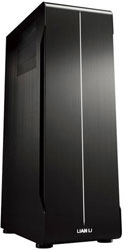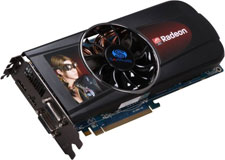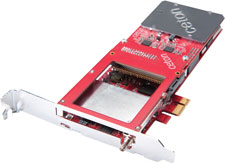Holiday 2010 System Builder's Guide
by AnandTech Staff, edited by Jarred Walton on November 19, 2010 2:00 AM EST- Posted in
- Guides
- Systems
- Holiday 2010
Alan's Ultimate HTPC: Bringing Total Entertainment to the Living Room
Our final build is for those of you who do not like to compromise with your HTPC. Are you tired of hooking up multiple streaming boxes to get all your internet content, NAS for secondary streamers, and another gaming system as well? There are numerous users out there, myself included, that love HTPC as well as gaming. There are many ways to skin the proverbial HTPC cat; this guide is for those of you who want it all in one box on your big screen. There will be sacrifices however, and those come in the size department and in the old pocket book. If you're looking for a small, quiet HTPC that isn't as powerful but doesn't cost an arm and a leg, go look at what Ganesh is pushing.
| Alan's Ultimate HTPC | ||
| Hardware | Component | Price |
| Processor |
Phenom II X6 1090T Black Edition (Thuban 45nm, 3.2GHz, 6x512K L2, 6MB L3, 125W) |
$210 |
| CPU HSF | Noctua NH-D14 | $75 |
| Motherboard | MSI 890FXA-GD70 (AMD 890FX AM3) | $200 |
| Video | Sapphire Radeon HD 5870 1GB (100281-3SR) | $300 |
| GPU HSF | Arctic Cooling Accelero Xtreme | $57 |
| TV Tuner | Ceton InfiniTV4 CableCARD Quad-Tuner | $400 |
| Memory |
G.Skill Ripjaws 2x4GB DDR3-1600 CL9 (F3-12800CL9D-8GBRL) |
$150 |
| OS Drive (SSD) | OCZ Vertex 2 120GB ($20 MIR) | $210 |
| Misc | Icy Dock MB882SP-1S-1B | $20 |
| Hard Drives | 3 x Western Digital Green 2TB (WD20EARS) | $300 |
| Optical Drive | LG UH10LS20 Blu-ray Combo Drive | $85 |
| Case | Lian Li PC-X2000F | $300 |
| Power Supply | Seasonic SS-560KM 560W (80 Plus Gold) ($15 MIR) | $115 |
| Mouse | Razer Mamba | $110 |
| Keyboard | Logitech diNovo Edge | $157 |
| Software | Windows 7 Professional 64-bit (OEM) | $135 |
| Software | Hipporemote Pro | $5 |
| Software | PowerDVD 10 Ultra | $90 |
| Misc | Powermat for iPhone 3GS (PMM-1PB-B2A) | $41 |
| Total System Price | $3015 | |

The first thing to look at for an HTPC is the case, and the most important feature in the case of an HTPC is noise. This is the major problem with multipurpose machines. Gaming cases tend to stay cool but also tend to be noisy and filled with enough LEDs to be mistaken for a flight beacon; after all gamers tend to want to highlight all their high-end hardware. Finding components that will both be cool enough for gaming and quiet enough for a home theater is the key here. A great best of both worlds case is the Lian Li PC-X2000F. At $299 from Newegg as of this writing, the case is pricey, but it currently sports a $200 saving (though that may disappear soon). At that price, I think it is an excellent buy for a home theater/gaming enthusiast.
New to this version is USB 3.0 support and a redesigned case layout. With five 140mm fans, dust filters, and anti vibration solutions, the air-cooling is both highly effective and extremely quiet. Sporting seven HDD bays with the installed back plates for hot-swappable fun, this case has plenty of room for media drives; just make sure your motherboard or RAID card have enough SATA connectors.
Speaking of storage, currently 2TB WD20EARS drives are shipping for $100 and are a great way to expand your media storage capabilities and tend to run on the quiet side of things—no need for a NAS when your HTPC case holds enough traditional HDDs to feed every other device in your home with media! The case is limited to 3.5" drives, but throwing your favorite SSD into an Icy Dock or similar device will allow you to push it right into one of the HDD back plates to get your OS and applications loading at high speed with no noise whatsoever.

For the GPU, I chose AMD because of the bitstreaming support for HD audio codecs. We can argue about performance with the 5870 and 6870, but the 5870 has been around enough that aftermarket cooling solutions are readily available. Add a Noctua cooler to your favorite CPU as well as an Arctic Cooler Accelero on your high-end AMD graphics card for cool and quiet gaming that won't leave you straining to hear during quiet movie scenes. We've also selected a high-efficiency, near-silent 560W power supply from Seasonic to keep everything running; the GPU + CPU combination generally means we need more power than a typical HTPC, but since this is the main feature of the Home Theater/Gaming we went higher end.
At this point, we've taken your NAS or Windows Home Server, HTPC, and gaming PC and combined them into one glorious entertainment system. You'll need help accessing all that media however. Free applications like Boxee and My Movies 3 can help sort local and internet content past what Windows Media Center offers, but pay applications like PowerDVD will integrate well with Media Center and will also play nice with My Movies adding Blu-ray capability into the mix. But there's still more….
The smartphone is one of the best ways I have found to control a Windows-based HTPC. With HippoRemote on your phone and HippoVNC booting on your PC, you can use your smartphone to seamlessly open Windows Media Center, Boxee, Hulu, or myriad other applications. The touchscreen on the phone then transforms into a remote interface designed for the application of your choice. It is a great way to navigate seamlessly between applications that bring you internet or media content without having to browse endless webpages, and there's no need to hack Media Center. The problem is, using your smartphone in this manner depletes the battery at a rapid rate; that's why adding a Powermat on the coffee table will address this problem and charge your smartphone/remote each time you set it down. You'll still want a good wireless mouse as well as a keyboard for gaming. I like the Razer Mamba mouse, while the Logitech Dinovo Mini or Edge are excellent options for the keyboard.

Last but not least, you can add cable TV into your HTPC with a Ceton InfiniTV 4 CableCARD tuner. Although quite expensive and backordered, they bring four simultaneous HD streams into your PC through a single card. Streams can be accessed in other rooms via the Xbox 360, or by adding a network bridge to the tuners (a process still in beta firmware, but it should be available by the time the cards are out of backorder). Or, if you're one of those looking to cut the cable, save $400 and stick with streaming video.
You can see my list of components up top, but play around with what works best for you. I went with an AMD setup to keep the cost slightly lower and chose a single GPU as the system will likely be hooked to an HDTV that will limit the resolution for gaming to 1920x1080. Sadly, the single most expensive item is the CableCARD tuner. But for around $3000, you'll be ripping Blu-rays onto 6TB of storage, controlling your media with your phone, and playing the latest games on your 1080p TV. Enjoy!










112 Comments
View All Comments
JarredWalton - Friday, November 19, 2010 - link
While it would be great if Bulldozer could run in current motherboards, all the information I've been able to gather (including asking a contact at a motherboard manufacturer) is that Bulldozer for desktops will run in AM3r2. That socket will be similar to AM3, and it will be able to accept and run current AM3 processors, but the reverse isn't true. So, in essence it's the AM2+ situation again.If you search AMD's site, there's no mention of AM3r2 that I can find outside of their forums. It's still possible that we're mistaken, but AMD hasn't unequivocally stated that "yes BD will work in current motherboards" so I wouldn't count on it. I think originally the idea was to try and make it happen, but now it's not guaranteed.
If you really want to go to the rumor mill, BD might actually work in current boards but might blow caps or have reduced performance. Maybe someone will come out with a fix. All indications however are that there will be new chipsets (980/990 most likely), a new socket requirements, etc. I guess it may be a lot like the socket 775 transitions from Intel where we had a few manufacturers that got older 945P chipsets to run Core 2 and such.
JarredWalton - Friday, November 19, 2010 - link
Just to add a bit more: Phenom X6 will technically work in many 790FX motherboards... but it's not the same as running it in an 890FX. 790FX wasn't designed for Turbo Core, it has some power management issues with Thuban, etc. We have seen similar issues with previous updates where a CPU would work, but it didn't perform optimally. We may see that with Bulldozer as well, where it will run in 800 series boards with a BIOS update but it very likely will run best with a new motherboard/chipset. If AMD and their partners can prove me wrong, I'd be very pleased, but based on at least one source I'm not holding out much hope.blotto5 - Saturday, November 20, 2010 - link
thanks for the info good to know since im running a phenom x6 in a 790fx mobo but i think im going to wait to buy a new mobo because of this talk of a new socket a la am2 to am2+baba264 - Friday, November 19, 2010 - link
This comes quite handy as after the death of my graphic card two days ago, I was seriously thinking of buying a new system that would be quite similar to "Ryan's High-End Gaming System".However, when I had previewed the various parts I wanted, I had set my mind on a new lynnfield core with an i7 870 rather than the old Bloomfield core. Since I don't plan to upgrade to an SLI setting I thought that the i7 870 was the best choice of processor (for the price), was I mistaken?
Anyway, thanks for the article, this article really comforts me in what I meant to buy.
Ryan Smith - Friday, November 19, 2010 - link
The 870 is quite good. In fact when I was putting that list together I was seriously considering that instead of an X58 platform. The clincher was SLI support (P55 boards with SLI quickly drive the price up); but since you're not going to be using SLI I wouldn't be concerned.mapesdhs - Friday, November 19, 2010 - link
P55 boards run very nicely SLI, easily outperforming X58 boards, and that's
with an 860, never mind an 870. See my results pages:
http://www.sgidepot.co.uk/misc/pctests.html
http://www.sgidepot.co.uk/misc/stalkercopbench.txt
Further tests coming soon with an 870 + GTX 460 FTW SLI.
it's only really 3-way SLI where X58 takes over. For 2-way, the speeds
are just as good (if not better) and the costs are significantly lower - the
board I'm using costs less than 70 UKP ($110).
Ian.
JarredWalton - Friday, November 19, 2010 - link
Color me confused, but those links don't seem to provide the data you're talking about. The question is how something like i7-930 with X58 compares to i7-860 with P55 while everything else is kept constant, and all the stuff there looks like 930 + 4870 CF or 460 SLI, and 860 + 8800 GT SLI, or some other sets of data. You'd need to show X58 460 SLI vs. P55 460 SLI to "prove" that P55 is "easily outperforming X58 boards". And if you do everything with similar quality components, the X58 ought to win out by virtue of having two x16 connects compared to two x8 connects on P55.mapesdhs - Friday, November 19, 2010 - link
(my friend has 4890s, not 4870s)
I'm surprised you'd say that given existing articles have already
shown that SLI doesn't need full 16x to perform nicely. Some games
need it because they're written badly (FSX), but others run perfectly
well at 8X, or even 4X.
Specific data coming soon (still testing) but my point was that the
existing data already shows the same effect - people on forums
said the 4890s should win, but they don't much of the time except
where resolution, etc. are a factor.
I'm still ploughing through my P55/460 tests. All takes time as I'm
sure you can appreciate. :)
Ian.
JarredWalton - Friday, November 19, 2010 - link
I'm not saying X58 is substantially faster by any means; I'm just saying that all things being equal there's no reason P55 should be faster. x8 vs. x16 isn't a huge benefit, but especially with higher clocked CPUs and more powerful GPUs (i.e. GTX 580 or HD 5870) the X58 should come out ahead. Anyway, Gary Key did a pretty direct comparison when he was still with us:http://www.anandtech.com/show/2847
In general X58 CF is better than P55 CF, though the margin is never so large as to be alarming. What Gary doesn't show is how the SLI setups compare (probably for lack of an SLI capable P55 board at the time he was with us). I'd figure they're also similar. All told, P55 is faster for single GPUs, but the x8+x8 dual-GPU configuration should and usually does incur a small performance hit.
mapesdhs - Saturday, November 20, 2010 - link
Generally true, though remember the one advantage which
can make a difference sometimes (and push it in favour
of P55) is the better Turbo on the 870, etc. For fixed
clocks, have a look at the CPU scores I get with the
860 at 4018 for the 3DMark06 CPU tests, compare to
my friend's 930 at 4136 (and btw, it's not RAM speed;
I lowered my RAM to match, scores only dropped 1
or 2%).
You're right though about the top-end cards/CPUs, if
I was playing at crazy res with expensive cards like
the 580 then X58 would be more logical. For midrange
though, like the 460 (with or without SLI), the gain from
X58 is minimal at best - the cost difference (which
may be large) can be used to have a better GPU,
widening the gap further.
And by cost difference I mean, for example, the Asrock
P55 Deluxe, which is now as cheap as 68 UKP here.
It has excellent slot spacing for SLI, ie. better cooling.
Either way, we shall see; after doing default tests, my
plan is to run the FTWs at lower clocks to match my
friend's Palit Platinums, that should be interesting.
All I'm saying is, don't be surprised if P55/SLI runs
better than you might expect. I certainly didn't think
two 8800GT SLI would be able to match or beat
an X58 with two 4890s, but they can and do.
Ian.